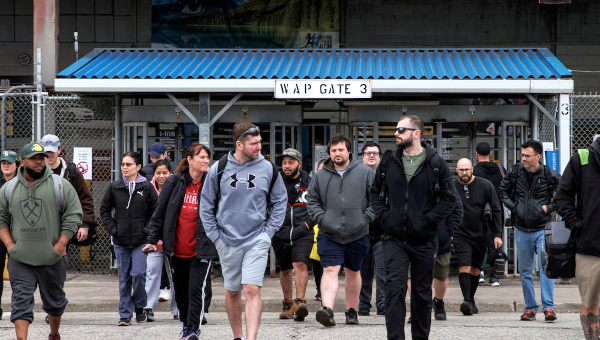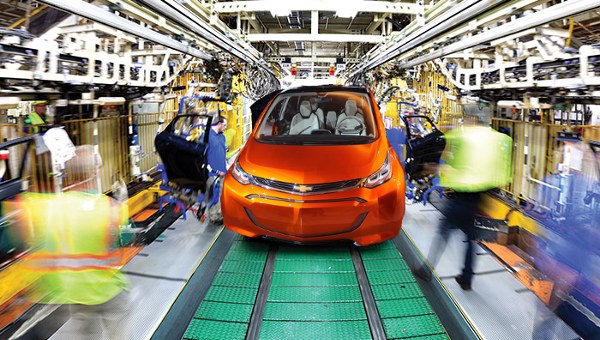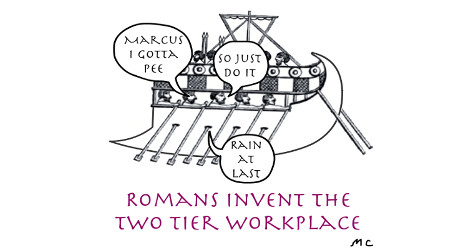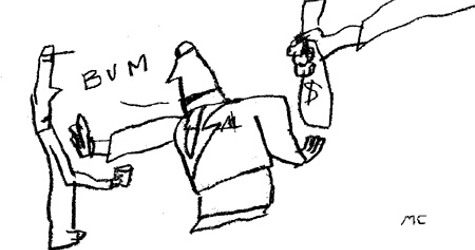Canadian Auto Isn’t in ‘Crisis’, It’s in Danger of Extinction
Canadian autoworkers have faced many crises over the years, but the present threat is distinct. Lana Payne, President of Unifor, has warned that “If we don’t push back hard against him [US President Donald Trump] and against these companies, we’re going to lose it all.” So far, the debate over what to do has started and stopped with Trump’s tariffs. But the threats go deeper, both for auto companies and for our ability as workers and citizens to determine democratically what kind of society we want – that is, for Canada’s substantive and not just formal sovereignty. Taking on these larger challenges demands coming to grips with some tough realities.
The starting point for a response must be that the tariffs are only a symptom of Canada’s larger dilemma: the over-dependence on the world’s dominant global power. We may be America’s long-standing ‘closest economic partner and most loyal ally’, but that hasn’t prevented Trump from treating us as a vassal state.

Beyond Tariffs
No-one would know, hearing the Trump Administration’s justification for tariffs against Canada, that the US actually has a trade surplus with Canada in manufactured goods, including auto. The tariffs were imposed in spite of this and driven, as US Secretary Treasurer Scott Bessent brazenly asserted, by the US determination to apply ‘the most America-first policies that are possible’.
Bessent added that the only qualifier was not ‘incurring market wrath’. This declaration that the only constraint America accepts is the US stock market, overwhelmingly the property of the rich (10% of the US population owns more stock than the other 90%), offers a remarkably bleak – if accurate – view of not just America’s international vision, but of US internal democracy.
Whatever the long-standing frustrations of many Canadians with our subordinate relationship to the US and a pervasive unease with what America represents, dissent was historically muted by the economic seduction of US goods, US markets, US investment, US technology and the alleged security of the US military umbrella. But today, a good many Canadians have learned – or relearned – that clinging to the US is a liability. Though Trump has brought antipathy for US unilateralism to a head, what we confront isn’t reducible to Trump. The problem preceded Trump and will remain after he’s long gone.
Canada is, of course, not alone in its dependence on the American Empire. Other countries, including other US allies, face similar anxieties. In Canada’s case, however, the dependence is however especially extreme and in the auto industry uniquely so. In auto, moving major Canadian assembly plants to the US is disruptive and costly, but comparatively easier than in other sectors and other countries. This is an effect of being part of a highly integrated continental industry with the main market being the US, and with the core research, development and planning decisions concentrated in the US.
Canada does have lower labour costs than the US, largely because of our lower dollar and the American stubborn refusal to adopt a universal public healthcare system. But unlike the huge labour cost differential between Mexico and the US (Mexico’s labour costs are about one-sixth that of the US) Canada’s labour cost advantage is not large enough to over-ride the uncertainties put in play by Trump’s pressures to relocate to the US.
Seeing corporations exiting Canada and the growing bias against future investment in Canada is appalling, but it should not be surprising. It’s precisely what Trump intended with his tariff threats. Even if the tariffs end and Trump and our Prime Minister hug each other, US corporations won’t forget this experience very easily. Caution in placing new work and production facilities in Canada will persist.
The Threat to Jobs on Both Sides of the Border
A second reality affects workers on both sides of the border. Autoworkers are in the firing line between an environmental crisis that can’t be avoided and an industry that, obsessed with its short-term profits, has failed to prepare for the evolving planetary climate catastrophe. This too predates Trump, though he has done everything he can to make it worse.
The contrast with China is stunning. While the North American corporations are actively delaying conversion to EVs (electric vehicles), China charges ahead. While the North American industry dithers, China has established secure access to the necessary EV supply chains and the required rare-earth minerals for EV batteries. While China subsidizes EV research, battery innovation, assembly costs, and constructs a national network of readily available recharging stations Trump doubles down on keeping gas prices low, reinforcing dependence on environmentally costly oil.

The North American based corporations shed crocodile tears about there being no demand for EVs, but China has demonstrated that if the price is right and if the recharging stations are readily at hand, consumers will come. As China’s production ramped up, economies of scale lowered the cost of EVs to the point that EVs in China now sell for about $20,000 – less than half the price of EVs here and elsewhere. EVs now account for about 50% of the market in China but only 10% of the US market and 15% of Canada’s.
To put these achievements in historical perspective, at the turn of this century the US vehicle sector was assembling more than six times that of China (even Canada was assembling about 50% more). China’s production was then only 3.4% of the global industry. Yet today, with electric vehicles being the future of the industry, China accounts for 7 of every 10 EVs produced globally. That’s the same ratio the US was producing of the world’s gasoline driven vehicles at the height of America’s postwar economic dominance in the mid-fifties.
The China-US contrast in the transition to EVs extends to their respective responses to energy renewables; China is far and away also the leader in solar and wind power. Acknowledging China’s impressive response to a fundamental threat to nature and humanity isn’t a matter of being ‘pro-China’. China clearly has its share of drawbacks, notably its weak worker and union rights and its undemocratic top-down rule.
The point rather is to shift blame from the alleged disinterest of North American consumers in EVs to the astonishing economic and technological failures of American capitalism to make EVs a practical consumer option. Given this historic failure it is incredulous to imagine corporate America and the American state leading the world out of the broader and far more complex environmental catastrophe before us.
Auto Can No Longer Deliver Jobs the Way it Once Did
A third reality is that the auto industry in the developed countries is not going to be – can’t be – the job creator it was in the past. The hundreds of thousands of auto jobs lost in Canada and the US over the decades are not coming back and, at best, only some of the existing jobs will be saved.
The reasons for this are clear: the environment won’t sustain further maximizing the cars on the road; the market for new vehicles in the developed capitalist countries is relatively saturated; whatever growth there is, is offset by productivity gains; and the shift to EVs will require significantly less labour per vehicle unless battery production also occurs in Canada. (There is as well the fact that international competition is shifting vehicle production away from the developed West, with China and Mexico being the main beneficiaries.)
In the US, motor vehicle jobs have fallen by over 20% since 2000, a loss of almost 300,000 jobs. This obscures the far larger impact on the American Mid-West, since it includes job gains in the American South. Since the turn of the century motor vehicles jobs in Michigan, Ohio, and Indiana fell by 46%, more than double the national US decline.
Asian and European corporations had come to the US to counter protectionist threats, but they avoided going where the auto jobs were being lost and went instead to the overwhelmingly non-union US South. Tariffs alone did little for manufacturing in the Mid-West. Though US jobs losses have flattened in the last half-dozen years, insecurity for autoworkers remains a permanent reality.
For Canada, jobs have declined by close to 30% – worse than in the US as a whole, but not as high as in the Mid-West, though the latest data predates the impact of the tariffs. In 2000, the US-based Big Three – GM, Ford, and Chrysler (now Stellantis) – had nine assembly plants in Canada. In spite of the massive subsidies over the years, no new plants have been added by the Big Three; four facilities have since closed; three are in limbo, waiting for products; and one has lost a shift and there is uncertainty about its future. Only two Big Three assembly plants are currently assembling motor vehicles (one expecting the addition of a third shift in 2026).
| Canadian Big Three Assembly Plants since 2000 | ||
|---|---|---|
| No. | ASSEMBLY PLANTS 2000 | CURRENT (November 2025) |
| 1 | GM St Therese | Closed 2002 |
| 2 | GM Oshawa car | Closed 2005 |
| 3 | GM Oshawa truck | Closed 2009 |
| 4 | Ford St Thomas | Closed 2011 |
| 5 | GM CAMI, Ingersoll | EV product suspended |
| 6 | Stellantis, Brampton | No product |
| 7 | Ford Oakville | EV truck dropped, gas-driven truck 2026 |
| 8 | GM Oshawa truck Silverado | 3 shifts, down to 2 in 2026, gas-driven |
| 9 | Stellantis Windsor | 2 shifts up to 3 in 2026 |
Toyota, with three non-union facilities (one of which is the only added assembly plant in the industry over this period) is now assembling more in Canada than the traditional Big Three combined. Add Honda’s two Canadian facilities and the assembly capacity of these two Japan-based companies will exceed that of the Big Three even if the Big Three plants in limbo get products. The message here, which Unifor is very aware of, is that unionizing the Japanese transplants has become as crucial today as unionizing GM and later Ford and Chrysler was in the 1930s.
Resistance is Paramount
No resistance essentially means giving up. Moving to tripling our military expenditures to make Trump love us only led, as should been expected, to Trump adding other demands. And the only thing more absurd than Ontario thinking of no better ads than praising US President Ronald Reagan is hearing that our Prime Minister ‘apologized’ to Trump for a Canadian jurisdiction putting out an ad that Trump didn’t like.
The boom in military expenditures, as is also the case in Europe, will mostly be spent buying US equipment and will divert government revenues from funding health, education, and social services for the poor, as well as from adequate investment for addressing the environment. In surrendering to US pressure, Canada is essentially trying to defend its sovereignty by becoming more like the US.
When unions began to accept, under duress, corporate demands for concessions in the eighties in exchange for promises of job security, an instructive lesson emerged. Giving in to bullying only reveals weaknesses and invites more concessions. The jobs didn’t come, unions lost credibility with their members, and workers and their unions were weakened for the battles to come.
Immediate Responses
What then can be done to salvage the reeling Canadian auto industry? Various immediate steps have been proposed to stop the hemorrhaging of the Canadian auto industry: fighting for products in suddenly idled plants, counter-tariffs, diversifying Canadian trade, joint-ventures with China, and an industrial strategy. Each is important yet even together they are limited.
Getting immediate product for existing facilities, rather than being brushed off with a ‘possibility’ of a future product down the road, is critical. As Unifor has insisted, passively leaving facilities idle reduces pressure on the corporation to deliver and risks such facilities fading from public attention. Moral outrage about broken promises is however unlikely to get the union very far. Every form of protest, including a revival of the union’s historical legacy of plant takeovers, has to be part of its arsenal.
Introducing counter-tariffs against the US, as Canada’s Prime Minister originally threatened, is unlikely to work as a tactic. On its own it would likely have little or no positive impact on Canadian jobs and no doubt lead to more US threats. But imposing counter-tariffs would nevertheless be a defiant assertion that we won’t be walked over without a fight. It might also rally other US allies to respond more aggressively. If Canada, the most dependent of US allies, has concluded it must challenge the US then why not them as well?
Diversifying our trade, including with China, now seems like straightforward common-sense. Doing so isn’t a matter of replacing our subservience to the US with a new dependency, but simply an overdue rebalancing of our overdependence on the US. Yet, here too, we should have no illusions that modest steps will solve Canada’s auto crisis. Canada has, for example, neither the leverage of China’s massive market and its vast pools of low-cost labour, nor China’s technological foundation. What space exists abroad is already occupied by China, and Europe also is looking to exports to offset the limits imposed by the US.
As for joint EV ventures with China, the US would surely block significant numbers of these vehicles flowing to the US market from Canada. In fact, it is already doing this even against US companies operating in Canada. Without assured access to the US market and with China not wanting to risk further overall US retaliation, it’s hard to imagine China considering such cooperation with Canada.
An ‘industrial strategy’, with the government playing a larger role in the economy, has long been raised and is now being resuscitated for auto and other sectors. But given the scale of the problem, some qualifiers are elemental. If the leadership role remains in private hands, with governments meekly trying to influence the direction through ‘incentives’, it won’t work. There is long experience to back this up. The government must lead, and public ownership will have to play a significant role.
Furthermore, focusing on the supply side is not enough. Markets for the output from an industrial strategy must be found and this again raises the planning role of the state as a purchaser of goods (more on this below). Above all linking an industrial strategy to markets can’t be left to corporate decisions on profitability and ‘competitiveness’. Such prioritizing of the corporate freedom to do what is best for their stockholders undermines our freedom to address our needs. The newly created markets must be reserved for our newly developed domestic productive capacity.
Among other things this highlights inevitable conflicts within industrial strategies. Worker and popular concerns may not, and generally will not, converge with business interests. As in all capitalist countries such differences in goals shape the policy responses. Working people may feel torn about how to respond – not surprisingly, since the issues are complex and the ‘Big Questions’ have for so long been obscured. But Canada’s economic elites and their state allies are clear. Their singular priority is returning to the pre-Trump trade status-quo which also brought pressures on Canadian workers and governments to ‘match’ (that is, be competitive with) the US, the country with the worst labour laws and weakest social programs amongst the core capitalist states.
Nationalist rhetoric can therefore be a trap – a vehicle to co-opt the labour movement into a ‘jointness’ within which labour is a subordinate player and its particular interests are defused. Notably, the opposition we would face in any serious alternatives posed from below would not be restricted to American corporations. Canadian businesses would in general be just as or even more antagonistic to unravelling the dependence of the Canadian working classes on the US.
Setting Our Sights Higher
The crippling point about political and economic dependency is that you can’t just snap your fingers and escape historic chains. If we look to counter what we are up against, there is no way out except to think bigger, much bigger. The immediate can’t be ignored but this must not come at the expense of developing and preparing for a longer-term response.
Significantly breaking the chains to the US would disrupt everything in Canada’s capitalist economy. Coping with this would demand a comprehensive degree of planning; as emphasized, it could not be done by tweaking markets and corporate incentives. And since you can’t plan what you don’t control it would also mean increased regulation of corporations and the development of state-owned companies to realize the plans. Overcoming Canadian dependency on the US consequently also forces overcoming our dependency at home on both major Canadian and American capital.
The new planning capacities would have to be democratic capacities in terms of whose interests they serve and how decisions are made. Economic restructuring, formerly a threat to workers, would potentially become an opportunity. Such historic transformations can’t happen overnight but raising them now provides markers – guideposts – to where we should be heading. In struggling with how to come to grips with what we’re up against, a number of points are fundamental.
First, while the union must fight to save what still has possibilities, if the corporations have decided to leave, it is no longer a realistic strategy to beg them to stay. It is then the productive capacities – the industrial spaces, flexible equipment, multi-purpose tool and die shops, the varied component capabilities – not the companies themselves that must become the target. These are assets we must not waste. Repeating the failed history of bribing them to stay is futile. Some corporations may stay and invest in Canada, but we can’t depend on this to solve the overwhelming threats we confront. Here especially the tactics will have to include reviving labour’s history of sit-ins and plant takeovers.
Second, we must set our sights beyond making vehicles. Making vehicles, especially ones more compatible with the environment is not to be dismissed, but the larger challenge lies in converting our rich productive potentials and developing them to produce the myriad of goods we need beyond auto.
Third, linking transformation in the production capacity in transportation to the environmental crisis may make the points more concrete. To address the environment, we will have to fix everything about how we live, work, travel, and play. For those asking what we will produce if we rely significantly less on the US market, the answer is that tackling the environmental challenge holds out a good part of the answer: accelerating the shift to EVs; converting all public vehicles to EV fleets made in Canada (postal vehicles, utility vehicles, ambulances, school buses, police cars); expansions in public transit vehicles and their infrastructure; retrofitting houses and offices; transforming workplace machinery; immense investments in renewable energy alongside the phased retreat from oil production.
Fourth, a National Conversion Institute could monitor developments, develop plans for needed goods and facilitate conversions and investment in new facilities. It would coordinate financing with local governments and their specific municipal environmental projects and with businesses supplying components. Provincial governments could set up local technology hubs in various communities where thousands of young engineering workers would research community and business needs and initiate or support engineering adjustments to produce new goods, services, and production methods.
Fifth, union locals, in the public as well as private sectors, could set up workplace committees to monitor whether their employer is planning cutbacks or closures, prepare for the worst if it does happen, and bring in the proposed National Conversion Center to address alternatives to maintaining production and services. Trade would still take place, but it would be integrated into the needs of the new, far more inward oriented domestic economy, not left to the free trade of private corporations.
Manufacturing has, for decades now, been downplayed as a fading part of the economy. But fixing and sustaining the environment can’t be done without manufacturing capacities. This includes meeting people’s yearly necessary social needs, such as the shortages in collective goods like housing, education and senior care, and reversing the erosion of community healthcare clinics, sports facilities and community centers. There is also the very considerable and urgent load of fixing and sustaining the environment. Rather than wondering what will happen to our excess labour, we may very well face a shortage of labour if we can achieve a political and social turn to meeting social needs and not market imperatives.
Conclusion: The Necessary Challenge of ‘Thinking Big’
In the early 1980s, Canadian workers confronted an acceleration of globalization, ruling economics and political elites looked toward closer integration with the US, Ottawa driving what came to be called neoliberalism (aptly summarized by Adolph Reed as ‘capitalism without a working-class opposition’). The UAW parent union to autoworkers in North America reluctantly accepted that there was no option but to give in to concessions demanded by the auto companies and was looking to impose this same defeatist position on its Canadian members.
Canadian autoworkers were in an historic bind. The parent union represented 90% of the Big Three workers in a uniquely integrated industry. The certifications recognizing the union were formally with the parent union. A split from the US would therefore mean losing not just the weight and resources of the far larger US parent union. It would also require recertifying all its hundreds of bargaining units. In choosing to defy the UAW central that had once inspired their own breakthroughs, Canadian autorworkers were also challenging some of the largest corporations in the world, their own government, and the trend to ever deeper integration with the US.
In spite of this, the union leadership in Canada understood that if it didn’t want to ‘lose it all’ it had to win its members over to breaking away from its American parent. Led by its President, Bob White, the confidence to take this necessary risk prevailed. The credibility this established for the newly independent Canadian Autoworkers (CAW) union in the wider society subsequently allowed it to lead, along with other Canadian unions and social movements, to fight against free trade, neoliberalism, and deepening integration with the US.
It was not, however, then clear to the CAW and Canadian autoworkers, nor the larger union movement, how much further they would need to go to succeed. Today that dilemma of the relationship to the US is back. Among the significant differences in the context today is that the weakening of the labour movement over the intervening years has left the labour movement no longer coping with the extent of our dependence on the US but primarily arguing for ending the tariffs and, effectively inviting greater integration with the US.
Building a different kind of society on the edges of the American empire is obviously an intimidating historical task. It’s easy to understand why people shy away from it. Yet thinking bigger is ultimately the only practical option if we want to escape our present impasse with its frustrations and demoralization. The exact steps and timing in soberly moving in this direction will ‘depend’. But what should not be avoided is at least starting the discussions – in our workplaces, union locals, communities, and nationally – on what we face, where we stand in response, what needs doing, and how we might do it.
Electoral politics will inevitably be necessary but past experience tells us that leaving this to the politicians will fritter away decisive action. The electoral world is only relevant if a social base has been built outside of parliament with the vision, commitment, solidarity, and confidence to drive the politics. This demands an institution laser-focused not on the next election but on building the social force that will one day make electoral activity truly relevant. The creation of such an institution – a ‘party’ of a different kind – is, ultimately, the critical missing piece in our struggles. •
The Socialist Project is especially interested in responses to the direction laid out here. Do you think it’s on the right track? Are you interested in hearing more? Interested in setting up a committee in your local or community and if so, what further information might be useful? Interested in helping organize a public forum on all this and if so, getting suggested speakers? Contact: info@socialistproject.ca







